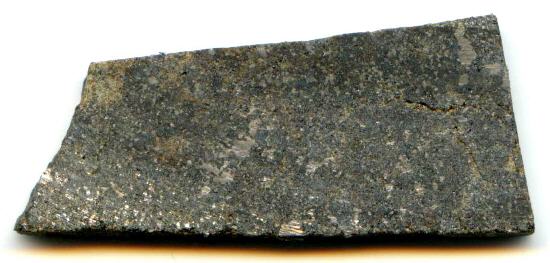CR7 or Meta-CR
(LL7 in MetBull 97)

Found 2007
no coordinates recorded A single stone weighing 533 g was found in Northwest Africa and purchased by F. Kuntz. A sample was submitted for analysis and classification (Wittke and Bunch, NAU; Irving, UWS) and NWA 5131 was found to have a mineralogical composition similar to that of LL chondritesChondrites are the most common meteorites accounting for ~84% of falls. Chondrites are comprised mostly of Fe- and Mg-bearing silicate minerals (found in both chondrules and fine grained matrix), reduced Fe/Ni metal (found in various states like large blebs, small grains and/or even chondrule rims), and various refractory inclusions (such Click on Term to Read More. However, following an O-isotopic analysis (Rumble III, Carnegie Institution; #5222), it could be demonstrated that the oxygen three-isotope plot falls within the CR chondriteClass named for the Renazzo meteorite that fell in Italy in 1824, are similar to CMs in that they contain hydrous silicates, traces of water, and magnetite. The main difference is that CRs contain Ni-Fe metal and Fe sulfide that occurs in the black matrix and in the large chondrules Click on Term to Read More field.
The
meteoriteWork in progress. A solid natural object reaching a planet’s surface from interplanetary space. Solid portion of a meteoroid that survives its fall to Earth, or some other body. Meteorites are classified as stony meteorites, iron meteorites, and stony-iron meteorites. These groups are further divided according to their mineralogy and Click on Term to Read More is a highly metamorphosed assemblage with strong similarities to the CR6 (or CR7, or
metachondriteTerm used to describe a metamorphosed chondrite. Also referred to as a type 7 chondrite. Metachondrites are texturally evolved rocks derived from chondritic precursors and some have been classified as primitive achondrites. Click on Term to Read More) Tafassasset. Fine-grained portions exhibit 120° triple junctions, while other areas consist of
mineralInorganic substance that is (1) naturally occurring (but does not have a biologic or man-made origin) and formed by physical (not biological) forces with a (2) defined chemical composition of limited variation, has a (3) distinctive set of of physical properties including being a solid, and has a (4) homogeneous Click on Term to Read More phases described as having a poikiloblastic texture, defining possible relict
chondrulesRoughly spherical aggregate of coarse crystals formed from the rapid cooling and solidification of a melt at ~1400 ° C. Large numbers of chondrules are found in all chondrites except for the CI group of carbonaceous chondrites. Chondrules are typically 0.5-2 mm in diameter and are usually composed of olivine Click on Term to Read More. These recrystallized
chondruleRoughly spherical aggregate of coarse crystals formed from the rapid cooling and solidification of a melt at ~1400 ° C. Large numbers of chondrules are found in all chondrites except for the CI group of carbonaceous chondrites. Chondrules are typically 0.5-2 mm in diameter and are usually composed of olivine Click on Term to Read More relicts would be consistent with a porphyritic, metal-bearing, olivine–
pyroxeneA class of silicate (SiO3) minerals that form a solid solution between iron and magnesium and can contain up to 50% calcium. Pyroxenes are important rock forming minerals and critical to understanding igneous processes. For more detailed information, please read the Pyroxene Group article found in the Meteoritics & Classification category. Click on Term to Read More chondrule type.
A more advanced stage of metamorphism than that exhibited by the CR6 chondrites
NWA 7317 (and pairings) and
NWA 3100 has been invoked to explain the recrystallized poikiloblastic texture in NWA 5131, and therefore the term metachondrite might be most appropriate for this meteorite (Wittke
et al., 2011). It has also been argued that the similarity in O-isotopic compositions that is observed among the non-metamorphosed CR chondrites, the metamorphosed CR6 chondrites, and NWA 5131, compared with the igneous
achondriteAn achondrite is a type of stony meteorite whose precursor was of chondritic origin and experienced metamorphic and igneous processes. They have a planetary or differentiated asteroidal origin where the chondritic parent body reached a sufficient size that through heating due to radioactive decay of 26Al (aluminum isotope) and gravitational Click on Term to Read More NWA 011 (and pairings), is consistent with their derivation from a common, large
parent bodyThe body from which a meteorite or meteoroid was derived prior to its ejection. Some parent bodies were destroyed early in the formation of our Solar System, while others like the asteroid 4-Vesta and Mars are still observable today. Click on Term to Read More, one which experienced internal
partial meltingAn igneous process whereby rocks melt and the resulting magma is comprised of the remaining partially melted rock (sometimes called restite) and a liquid whose composition differs from the original rock. Partial melting occurs because nearly all rocks are made up of different minerals, each of which has a different melting Click on Term to Read More while retaining a chondritic
regolithMixture of unconsolidated rocky fragments, soil, dust and other fine granular particles blanketing the surface of a body lacking an atmosphere. Regolith is the product of "gardening" by repeated meteorite impacts, and thermal processes (such as repeated heating and cooling cycles). Click on Term to Read More.
Northwest Africa 5131 is a recrystallized meteorite that is petrographically consistent with a low-degree partial melt of Renazzo-like precursor material which has retained its
metalElement that readily forms cations and has metallic bonds; sometimes said to be similar to a cation in a cloud of electrons. The metals are one of the three groups of elements as distinguished by their ionization and bonding properties, along with the metalloids and nonmetals. A diagonal line drawn Click on Term to Read More component. The rock subsequently experienced equilibration processes through an extended period of thermal metamorphism. The specimen of NWA 5131 shown above is a 2.73 g partial slice.







